The Race to Save the Lord God Bird (6 page)
Read The Race to Save the Lord God Bird Online
Authors: Phillip Hoose

All in all, Wayne's field journals show that he killed or paid for the killing of forty-four Ivory-billed Woodpeckers in Florida between 1892 and 1894. According to researcher James Tanner, who interviewed some of Wayne's “country crackers” in the 1930s, Wayne's work all but eliminated the Ivory-bill along three Florida rivers. Of these birds, Brewster bought only seven, paying an average of about twelve dollars per bird. Brewster also bought fifty-four specimens from other collectors, eventually giving him one of the largest collections of Ivory-bill specimens in the world.
WHAT'S HIT IS HISTORY
Why did Arthur Wayne need to kill forty-four Ivory-billed Woodpeckers, and why did William Brewster need to buy sixty-one specimens? Didn't they realize the bird was nearing extinction? If so, didn't they care?
Of course they knew Ivory-bills were rareâthat's what made them valuable. Wealthy collectors like Brewster competed fiercely to buy the few specimens of rare and almost extinct birds. Brewster was both a scientist and a collectorâduring the late 1800s there wasn't always a clear distinction between the two. As a scientist, he wanted a large number of specimens to study all the variations found in birds of different sexes and ages, and from different parts of their range. Males and females look different in most species, as do juveniles and adults, as do birds in, say, the northern extreme of where they live compared to those in southern locations. To really understand a species as a whole, it's important to observe these differences, and to try to understand what they mean to the birds themselves.
William Brewster wrote a great deal about birds and made valuable scientific contributions to ornithology. So did Arthur Wayne: he discovered many new species in South Carolina and wrote the first field guide to the birds of South Carolina, still considered
a masterpiece of detail. And in those days, before cameras, an assortment of field guides, and binoculars, the most reliable way to study birds was to kill them and examine them closely. Without specimens, we would not have the foundation of knowledge upon which ornithology rests. Collecting was a big part of what ornithologists did.
a masterpiece of detail. And in those days, before cameras, an assortment of field guides, and binoculars, the most reliable way to study birds was to kill them and examine them closely. Without specimens, we would not have the foundation of knowledge upon which ornithology rests. Collecting was a big part of what ornithologists did.
But the question still remains: Why did they need so many? If people like Brewster and Wayne knew so much and cared so much about birds, wouldn't they have wanted to keep a species like the Ivory-bill alive at all costs? Maybe. Neither man knew for sure how many Ivory-bills were left, since there was still no way to make a reliable count of all the individual birds within a species' range.
Neither man seemed willing or able to believe that his actions could be contributing to the demise of the Ivory-bill. When Wayne wrote about the Ivory-bill's disappearance on the Wacissa River in Florida, he blamed it on the men he was paying to kill them. “This magnificent bird was once very common in this region,” Wayne wrote, “ ⦠but it is now rapidly becoming extinct on the Wacissa ⦠They are shot for food, and the peopleâthe crackersâconsider them better than ducks!”
CABINETS AND PRIVATE MUSEUMS
“This bird is not at all abundant,” wrote one collector of the Ivory-bill in 1879, “and specimens may be regarded as good additions to one's cabinet.” By “cabinet” the writer meant the grandfather-clock-sized cases with glass windows that loomed in the parlors of the wealthy throughout America and Europe during Victorian times. They were jammed with stuffed birds clinging to dried vegetation, dried butterflies, decorative stones, seashells, dead beetles, birds' eggs and nests, and even stuffed frogs.
A few extremely wealthy collectors like William Brewster built huge personal museums, collecting tens of thousands of dead birds, which were stuffed and exhibited. Brewster had 40,000 skins when he died, the second-largest collection in North America. He willed it to Harvard University, where it is now part of Harvard's Museum of Comparative Zoology. Like all collectors, these men and women bought multiple specimens of the same species to trade with other museums.
In Brewster's day, the largest collection in the world was owned by Lord Rothschild of Tring, England, a fabulously wealthy man who personally owned more than 300,000 bird skins and mounts by the time he died in 1937.
Extinction was not a big topic when Brewster and Wayne were collecting. When whites first settled North America, many believed there were so many birds that it was impossible to completely destroy a species. By the time of Brewster and Wayne, scientists knew that the Great Auk and the Heath Hen and the Labrador Duck were gone and that others might soon follow. A few scientists and collectors were beginning to think about the danger their work posed. “The true ornithologist goes out to study birds alive and destroys some of them simply because that is the only way of learning their structure and technical characters,” wrote ornithologist Elliott Coues in 1890. But his was a rare voice. Even those who noticed that particular birds were missing were not thinking about protecting the
habitat for endangered species. And there was little understanding of the role that any one species played within an entire ecosystem. Bird experts were still fixed on collecting, stuffing, studying, and writing about species. As many put it, “What's hit is history, what's missed is mystery.”
habitat for endangered species. And there was little understanding of the role that any one species played within an entire ecosystem. Bird experts were still fixed on collecting, stuffing, studying, and writing about species. As many put it, “What's hit is history, what's missed is mystery.”
Those who traded in rare birds probably didn't want to know that their work was pushing a bird toward extinction. Ivory-billed Woodpeckers meant money to Arthur Wayne and prestige to William Brewster. Wayne was able to sell his Ivory-bills for about ten dollars on average. He had to pay his “crackers” four or five dollars per bird, so if he either bought or killed forty-four birds, he might have made at least three hundred dollars, minus the cost of his supplies and his travel to and from Florida. It wasn't a fortune even then, but it meant a lot to Wayne, who desperately wanted to view himself as a professional ornithologist.
Collectors took eggs from nests and removed the contents with a straw. Egg prices were listed in catalogues such as “The Oologist” (meaning one who studies eggs)
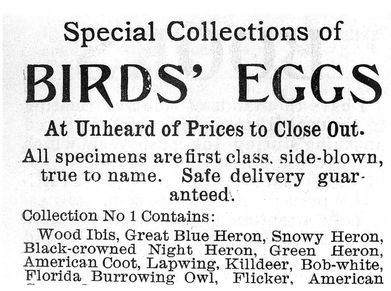
In the end, no matter what damage their work did to a particular species, the collectors kept collecting because they loved to. As one writer put it, “Collecting provided a convenient and socially acceptable excuse for respectable grown men to climb trees, scramble down cliffs, go camping and roam freely out of doors.”
Arthur Wayne and William Brewster: bird scholars, bird shooters, bird traders. Collectors. As leaders in the field of ornithology, they asked many important questions. But while Wayne stuffed the big black-and-white skins with cotton and Brewster packed his cabinets full of well-formed specimens, one question they never seemed to ask was “Is there still time for the Ivory-billed Woodpecker?”
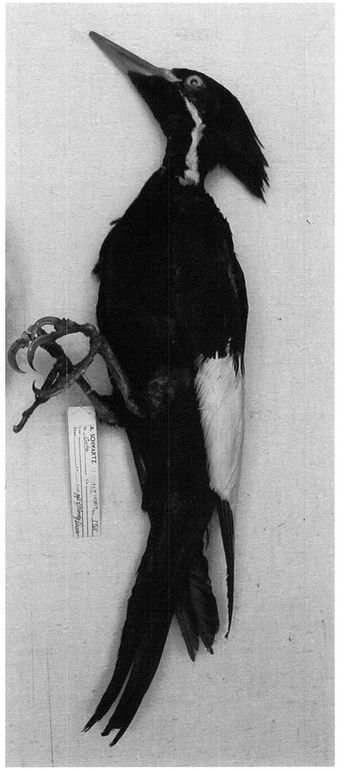
The widespread use of feathers on ladies' hatsâor even of whole birds, as seen hereâsparked the Plume War
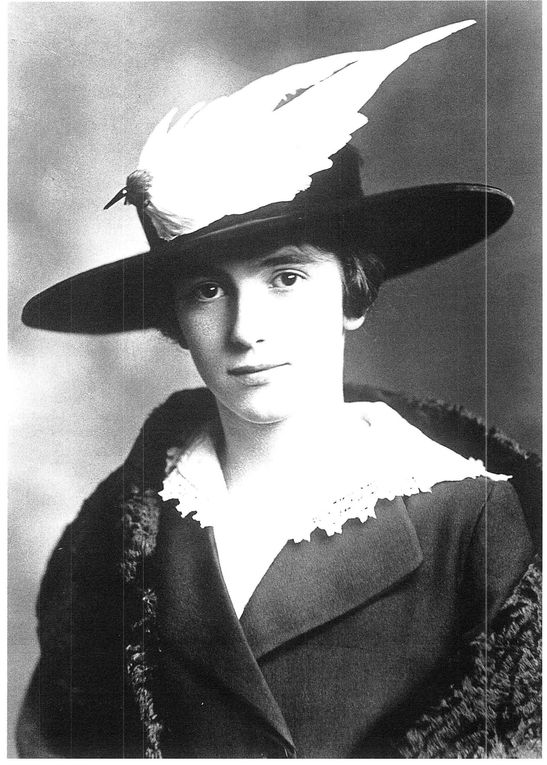
THE PLUME WAR
A bird in the bush is worth two in the hand.
âMotto adopted in 1899 by
Bird-Lore,
which became the official magazine of the
National Association of Audubon Societies of North America
Bird-Lore,
which became the official magazine of the
National Association of Audubon Societies of North America
F
EW WOMEN OUT WINDOW-SHOPPING IN NEW YORK CITY ON A WARM SPRING DAY in 1887 noticed the square-faced, bespectacled man strolling slowly behind them, pausing every now and then to scribble something down in a notebook. Those who did might have found it curious that his eyes rarely wandered below the tops of their heads. The man was Frank Chapman, an ornithologist for the American Museum of Natural History, and in some ways he was doing what he often did: counting birds.
EW WOMEN OUT WINDOW-SHOPPING IN NEW YORK CITY ON A WARM SPRING DAY in 1887 noticed the square-faced, bespectacled man strolling slowly behind them, pausing every now and then to scribble something down in a notebook. Those who did might have found it curious that his eyes rarely wandered below the tops of their heads. The man was Frank Chapman, an ornithologist for the American Museum of Natural History, and in some ways he was doing what he often did: counting birds.
But this was the most disturbing bird tally he had ever done. Chapman wanted to see for himself just how far the plumed hat fashion craze had gone. After two blocks of strolling, he walked briskly back to his office and compiled the grim statistics: he had seen 700 hats, of which 542 had feathers sewn into them. There were feathers from forty different species, including woodpeckers, bluebirds, flycatchers, owls, herons, and warblers. Some of the hat brims were like small tabletops, holding up great heaps of feathers. And it wasn't just feathers: one of the spring's most admired styles contained the beak, claws, and legs of a dead crow. Something had to be done.
In the early twentieth century ancient trees were cut out of swamps, crowding the lvory-bill into smaller forests, widely separated from each other
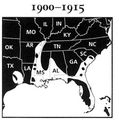
Frank Chapman became a key soldier in the “Plume War,” a struggle to keep birds from being slaughtered so that hats could be decorated with their feathers, or
“plumes.” The war lasted nearly fifty years. During this time, passions boiled, fortunes changed hands, and men were even killed. Out of this bitter fight came America's first conservation groups, including the Audubon Society, which later took the lead in trying to save the Ivory-billed Woodpecker. The Plume War also gave birth to strong bird protection laws and created the first nature preserves for birds. Perhaps most important, during this time millions of American schoolchildren fished dimes out of their pockets and became Junior Audubon members, learning to study and protect birds rather than shoot them. There may not have been uniformed soldiers in the Plume War, but plenty of blood was shed and millions of lives were lost.
“plumes.” The war lasted nearly fifty years. During this time, passions boiled, fortunes changed hands, and men were even killed. Out of this bitter fight came America's first conservation groups, including the Audubon Society, which later took the lead in trying to save the Ivory-billed Woodpecker. The Plume War also gave birth to strong bird protection laws and created the first nature preserves for birds. Perhaps most important, during this time millions of American schoolchildren fished dimes out of their pockets and became Junior Audubon members, learning to study and protect birds rather than shoot them. There may not have been uniformed soldiers in the Plume War, but plenty of blood was shed and millions of lives were lost.
FEATHERED GOLD
For centuries a plume sticking out of one's hat had been a jaunty mark of distinction in Europe. Napoleon wore a plume. So did fictional characters like the Three Musketeers, Captain Hook, and Cyrano de Bergerac. Around 1850, European women began to wear plumed hats, too, and by about 1870, the fashion trend had taken such a powerful hold in the United States that many American women wouldn't think of buying a hat that wasn't topped by at least one long bird feather.
A Snowy Egret
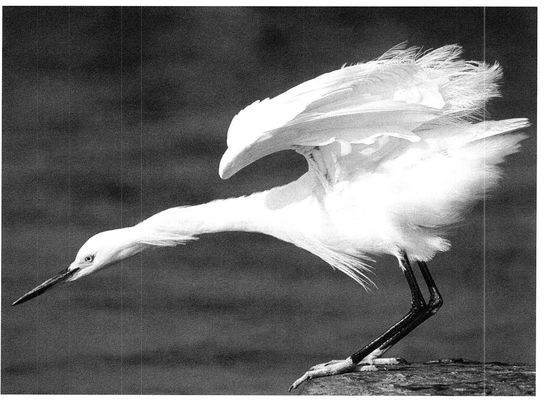
Suddenly there was even more money to be made from bird carcasses than could be earned by shooting specimens to stock museums or specimen cabinets. Millinersâhatmakersâwere paying high prices to hunters who would gun down brightly colored birds, strip the feathers from their carcasses, and pack the feathers into bales for shipment to Europe or New York. By 1900, one of every eighty-three Americans was employed in the hatmaking business. Three years later, an ounce of plumesârequiring the death of four birdsâwas worth twice as much as an ounce of gold.
The most valuable feathers of all were produced by two tall, long-legged wading birds called the Great Egret and the Snowy Egret. During their spring breeding seasons, their plumes, called “aigrettes,” were long, silky, and elegant, extending from the bird's shoulders to its feet. Especially when aigrettes started selling for a dollar a feather, plume hunters slipped into rookeries (clusters of heron and egret nests) and opened fire. Most adult birds remained with their eggs and nestlings instead of flying to safety. Stories of massacres soon reached the nation's newspapers. One witness wrote, “Here and there in the mud lay the lifeless forms of eight of the birds. They had been shot down and the skin bearing the plumes stripped from their backs. Flies were busily at work ⦠In four of the nests young orphan birds could be seen who were clamoring piteously for food which their dead parents would never again bring to them.”
On a January day in 1896, a bird-loving Boston woman decided she had read one such story too many. Harriet Hemenway was wealthy, well connected, and born to lead. She took her well-worn copy of the
Boston Blue Book
âa directory of Boston's wealthy and elite citizensâand began to thumb through it with her cousin Minna Hall. “We marked the ladies of fashion who would be likely to wear aigrettes on their hats or in their hair,” Minna Hall later wrote. “We then sent out circulars asking the women to join a society for the protection of birds, especially the egret. Some women joined and some who preferred to wear the feathers would not join.”
Boston Blue Book
âa directory of Boston's wealthy and elite citizensâand began to thumb through it with her cousin Minna Hall. “We marked the ladies of fashion who would be likely to wear aigrettes on their hats or in their hair,” Minna Hall later wrote. “We then sent out circulars asking the women to join a society for the protection of birds, especially the egret. Some women joined and some who preferred to wear the feathers would not join.”
CHRISTMAS BIRD COUNTS
In 1900, Audubon leader Frank Chapman proposed “a new kind of Christmas side hunt in the form of a Christmas Bird Census.” He asked that all readers of Bird-Lore magazine spend part of Christmas Day counting the birds around them and sending in a report of which species they saw and how many of each they counted. Twenty-seven people went out that day, reporting ninety species.
A century later, the Christmas Bird Count still continues, with more than fifteen hundred counts going on throughout the United States, Canada, and a few other countries. Many thousands of people take part recording what amounts to a giant snapshot of how birds are doing on that particular day. With over one hundred years of records, the counters can show whether a particular species is increasing, decreasing, or staying steady over time. And they have a lot of fun. Counters have recorded as many as 350 species near the Panama Canal, and as few as oneâthe Common Ravenâat Prudhoe Bay, Alaska.
Hemenway and Hall called their new organization the Massachusetts Audubon Society. Audubon chapters began to spring up in state after state as concern for plumed birds spread. Frank Chapman started a magazine called
Bird-Lore
for the Audubon Societies, with each issue including articles for children. Thousands of children joined Junior Audubon Clubs, learning to draw and paint birds and then plunging into the fields and woods to study them in real life. Some got free memberships but only if they signed a pledge card saying “I promise not to harm our birds or their eggs, and to protect them both whenever I am able.”
Bird-Lore
for the Audubon Societies, with each issue including articles for children. Thousands of children joined Junior Audubon Clubs, learning to draw and paint birds and then plunging into the fields and woods to study them in real life. Some got free memberships but only if they signed a pledge card saying “I promise not to harm our birds or their eggs, and to protect them both whenever I am able.”
The winners of an Audubon-sponsored birdhouse design contest in 1917 show off their entries
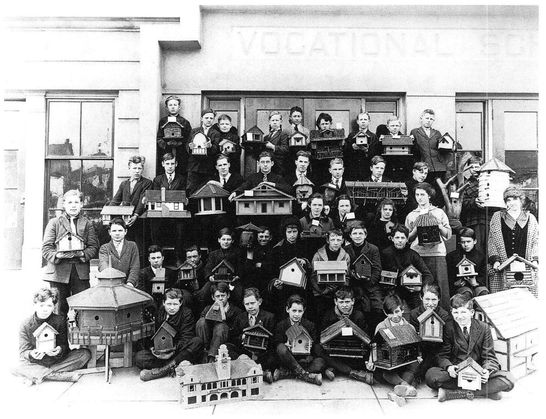
In 1905, state Audubon chapters became even stronger by forming the National Association of Audubon Societies, with headquarters in New York City. Leaders gave
public lectures, often blaming the Plume War more on the women who bought plumed hats than on the hunters who killed and sold the birds or the milliners who bought them.
public lectures, often blaming the Plume War more on the women who bought plumed hats than on the hunters who killed and sold the birds or the milliners who bought them.
The Audubon Societies pushed bird protection laws through legislatures in state after state, and followed up by hiring armed wardens to patrol the rookeries. But with plumed hats still in style, there was always money to be made, and hunters continued to blast away. Hunters and armed wardens circled each other warily in the last few great rookeries. With so much at stake, a showdown was inevitable.
MURDER AT CUTHBERT LAKE
Heretofore the price has been the life of the birds, now is added human blood.
âBird-Lore
magazine, 1905
magazine, 1905
Â
One desolate, mosquito-infested patch of south Florida is remembered as the Gettysburg of the Plume War. Cuthbert Lake was a shallow pond fringed by a tangle of mangrove trees, set deep in the Everglades. It had been named for a plume hunter who, as legend had it, had followed a drifting white feather into the Everglades until it led him to a giant rookery hidden deep in a mangrove swamp. When he pushed aside the last branches and beheld the multitude of wading birds before him, his eyes widened like those of a gold prospector who had seined a nugget in his pan. Cuthbert raised his rifle and shot until his ammunition gave out.
Plume hunters display their bounty
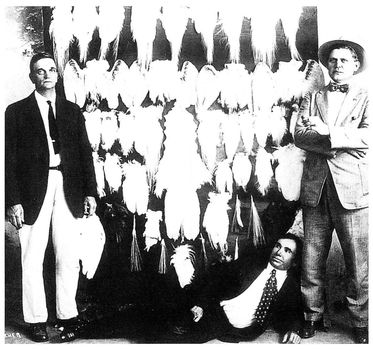
When Florida passed a bird protection law in 1905, the president of the organization later called the National Audubon Society
hired rugged, sunburned Guy Bradley to defend the last big rookeries in the Florida Keys. Bradley knew the Keys, and he knew many of the plume hunters personally since he himself had grown up hunting birds for pay. At the age of sixteen he, with his brother Louis and three friends, had sailed around the tip of Florida, collecting birds for a Miami taxidermist known as “the Frenchman.” He had had the time of his life back then, but now, at thirty-five, Bradley had soured on the plume trade. Anyone could see that there were many fewer birds now, and yet the hunters snickered at the new law. When Audubon's president offered thirty-five dollars a week for a warden's position, Bradley didn't hesitate. He knew it was dangerous, but he had two young boys to feedâand he believed in the work.
hired rugged, sunburned Guy Bradley to defend the last big rookeries in the Florida Keys. Bradley knew the Keys, and he knew many of the plume hunters personally since he himself had grown up hunting birds for pay. At the age of sixteen he, with his brother Louis and three friends, had sailed around the tip of Florida, collecting birds for a Miami taxidermist known as “the Frenchman.” He had had the time of his life back then, but now, at thirty-five, Bradley had soured on the plume trade. Anyone could see that there were many fewer birds now, and yet the hunters snickered at the new law. When Audubon's president offered thirty-five dollars a week for a warden's position, Bradley didn't hesitate. He knew it was dangerous, but he had two young boys to feedâand he believed in the work.
One of his first acts was to arrest several men he knew well. Suddenly old friends lowered their voices when he walked into a room. Then, on the morning of July 8, 1905, a Saturday, Bradley squinted out from the front porch of his cottage at the tip of the Everglades and saw a white sailboat heading across Florida Bay toward Cuthbert Lake. He scrambled to the shore, pushed his own small rowboat into the water, and took off after it. That was the last anyone saw of Guy Bradley. A few days later, a pair of boaters, curious about the vultures hovering above what appeared to be an empty rowboat, discovered Bradley's bullet-riddled body inside. Plume hunters were arrested for Bradley's murder but were soon released.
THE BOB
A new hairstyle helped end the Plume War. In 1914, actress and famed dancer Irene Castle appeared in a show with her hair cut short and blunt. She called it a “bobbed” cut. She had cut her hair to prepare for an appendectomy, and it hadn't had time to grow back for her performance. It didn't matter: her new look caught on immediately. Soon acres of hair were piled up on beauty parlor floors. Bobbed hair made heads too small to hold up the huge, tabletop-sized hats that had been loaded down with bird feathers. Demand for feathers lessened as the “bob” took over.
Two more Audubon wardens were murdered not long afterward. Public opinion swung sharply against the plume hunters and in favor of the Audubon Society. More and more women refused to buy feathered hats and pressured their friends to do the same. President Theodore Roosevelt threw his weight behind the Audubon movement, helping to close down the factories where birds were made into skins. There were victories in the swamps, too: in 1909 wardens finally tracked down the elusive plume hunter Arthur Lambert, a mastermind at staying one step ahead of the law. Once, Lambert had escaped officers by leaping from a boat into the Sampit River and swimming underwater to the other side, melting like an otter into the reeds along the far bank. Lambert
was later arrested when wardens, acting on a tip, flung open the lid of a steamer trunk and trained their pistols on him.
was later arrested when wardens, acting on a tip, flung open the lid of a steamer trunk and trained their pistols on him.
In 1910, New York outlawed the sale or possession of feathers from protected species, including herons and egrets. It was a major victory for the Audubon movement, since most of the country's hatmakers operated out of New York City, but it came almost too late. That same year, scientists estimated that there were only about 1,400 Great Egrets and 250 Snowy Egrets left in the world.
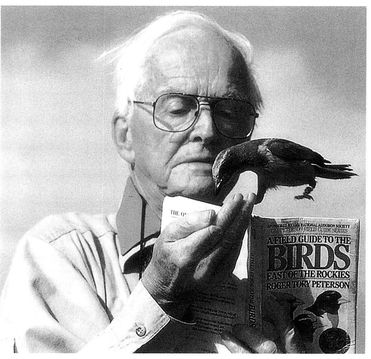
Three years later, the U.S. Congress prohibited anyone from bringing into the United States the “feathers, quills, heads, wings, tails, skins or parts of skins of wild birds ⦠except for scientific or educational purposes.” Soon elegant ladies stepped off ocean liners fresh from buying sprees in Paris or London, only to be greeted by polite U.S. customs agents who flashed badges and took their hats away.
Other books
Succulent Prey by Wrath James White
Devlin's Luck by Patricia Bray
The Galliard by Margaret Irwin
His Number One Fan by Wallace, Danyell
Elam by Kathi S. Barton
A Pack Family by Shannon Duane
The Healer: First Touch by Amy Clapp
The Training of a Marquess by Sandra Owens
Broken by Willow Rose
Only Make Believe by Elliott Mackle
